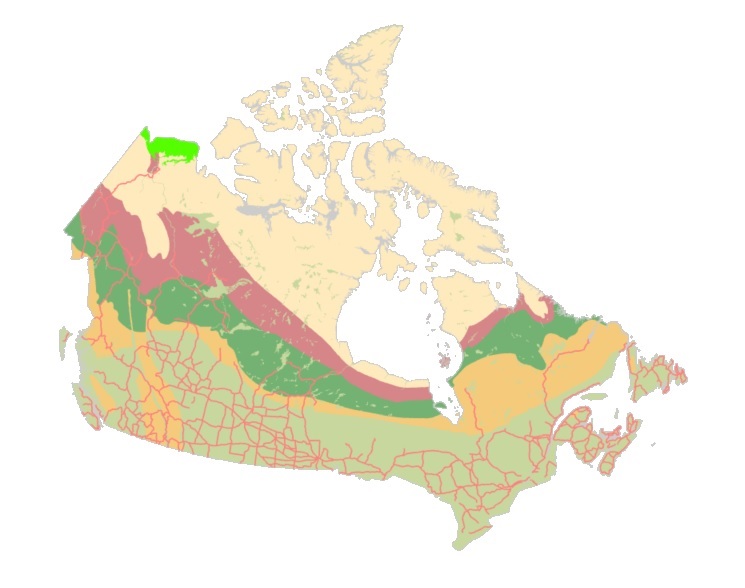MXD
Type of resources
Available actions
Topics
Keywords
Contact for the resource
Provided by
Formats
Representation types
Update frequencies
status
Resolution
-

The "Starter Kits" of the Canadian Geospatial Data Infrastructure (CGDI) are curated bundles of geospatial data delivered as a service. These kits are the result of a user needs assessment commissioned by Natural Resources Canada (NRCan), with a primary focus on addressing the specific requirements of Indigenous Peoples. Within these kits, you'll discover a selection of data provided as a service from a collection of over 71,000 datasets falling under the "Nature and Environment" category sourced from CGDI's Federal and Provincial/Territorial partners. These Starter Kits have been thoughtfully crafted into four thematic or geographic areas of Canada: a) British Columbia, b) Northwest Territories, c) Climate Change across Canada, d) And Water Resources across Canada. Each of these kits represents diverse areas and data categories, offering new users a compact, comprehensive, and user-friendly gateway to explore a wide array of information provided by the CGDI.
-
Data provided shows grants and contributions provided to Canadian firms by National Research Council (NRC) and its Industrial Research Assistance Program (IRAP) between April 1, 2020 and March 31, 2021.
-

Data provided shows grants and contributions provided to Canadian firms by National Research Council (NRC) and its Industrial Research Assistance Program (IRAP) between April 1, 2025 and March 31, 2026.
-
Data provided shows grants and contributions provided to Canadian firms by National Research Council (NRC) and its Industrial Research Assistance Program (IRAP) between April 1, 2021 and March 31, 2022.
-
Census subdivision (CSD) is the general term for municipalities (as determined by provincial/territorial legislation) or areas treated as municipal equivalents for statistical purposes (e.g., Indian reserves, Indian settlements and unorganized territories). Municipal status is defined by laws in effect in each province and territory in Canada. Census subdivisions (CSDs) are classified into 53 types according to official designations adopted by provincial/territorial or federal authorities. Two exceptions are 'subdivision of unorganized' (SNO) in Newfoundland and Labrador, and 'subdivision of county municipality' (SC) in Nova Scotia, which are geographic areas created as equivalents for municipalities by Statistics Canada, in cooperation with those provinces, for the purpose of disseminating statistical data. The census subdivision type accompanies the census subdivision name in order to distinguish CSDs from each other, for example, Balmoral, VL (for the village of Balmoral) and Balmoral, P (for the parish / paroisse (municipalité de) of Balmoral).
-
Data provided shows grants and contributions provided to Canadian firms by National Research Council (NRC) and its Industrial Research Assistance Program (IRAP) between April 1, 2018 and March 31, 2019.
-
Data provided shows grants and contributions provided to Canadian firms by National Research Council (NRC) and its Industrial Research Assistance Program (IRAP) between April 1, 2023 and March 31, 2024.
-

Small area data (SAD) on field crops show seeded and harvested area, yield and production estimates for most principal field crops and some special crops in Canada. Most SAD geographies correspond exactly with the Census Agriculture Region (CAR) limits, excepts for some regions of Quebec (where small areas are defined by provincial administrative boundaries), Saskatchewan (where small areas coincide with census divisions boundaries as of 2017) and British Columbia. For exact correspondence between Census Agricultural Regions (CAR) and Small Area Data (SAD) Regions, see the following link: https://www.statcan.gc.ca/eng/statistical-programs/document/3401_D2_V2 These regions are associated with Statistics Canada estimates on principal field crops available in the following table: https://www150.statcan.gc.ca/t1/tbl1/en/tv.action?pid=3210000201
-
Drought is a deficiency in precipitation over an extended period, usually a season or more, resulting in a water shortage that has adverse impacts on vegetation, animals and/or people. The Climate Moisture Index (CMI) was calculated as the difference between annual precipitation and potential evapotranspiration (PET) – the potential loss of water vapour from a landscape covered by vegetation. Positive CMI values indicate wet or moist conditions and show that precipitation is sufficient to sustain a closed-canopy forest. Negative CMI values indicate dry conditions that, at best, can support discontinuous parkland-type forests. The CMI is well suited to evaluating moisture conditions in dry regions such as the Prairie Provinces and has been used for other ecological studies. Mean annual potential evapotranspiration (PET) was estimated for 30-year periods using the modified Penman-Monteith formulation of Hogg (1997), based on monthly 10-km gridded temperature data. Data shown on maps are 30-year averages. Historical values of CMI (1981-2010) were created by averaging annual CMI calculated from interpolated monthly temperature and precipitation data produced from climate station records. Future values of CMI were projected from downscaled monthly values of temperature and precipitation simulated using the Canadian Earth System Model version 2 (CanESM2) for two different Representative Concentration Pathways (RCP). RCPs are different greenhouse gas concentration trajectories adopted by the Intergovernmental Panel on Climate Change (IPCC) for its fifth Assessment Report. RCP 2.6 (referred to as rapid emissions reductions) assumes that greenhouse gas concentrations peak between 2010-2020, with emissions declining thereafter. In the RCP 8.5 scenario (referred to as continued emissions increases) greenhouse gas concentrations continue to rise throughout the 21st century. Multiple layers are provided. First, the mean annual Climate Moisture Index is shown across Canada for a reference period (1981-2010). Projected mean annual Climate Moisture Index is available for the short- (2011-2040), medium- (2041-2070), and long-term (2071-2100) under the RCP 8.5 (continued emissions increases) and, for the long-term (2071-2100), under RCP 2.6 (rapid emissions reductions). Reference: Hogg, E.H. 1997. Temporal scaling of moisture and the forest-grassland boundary in western Canada. Agricultural and Forest Meteorology 84,115–122.
-
NHS as officially accepted by the Council of Ministers, mapping by Transport Canada.
 Arctic SDI catalogue
Arctic SDI catalogue